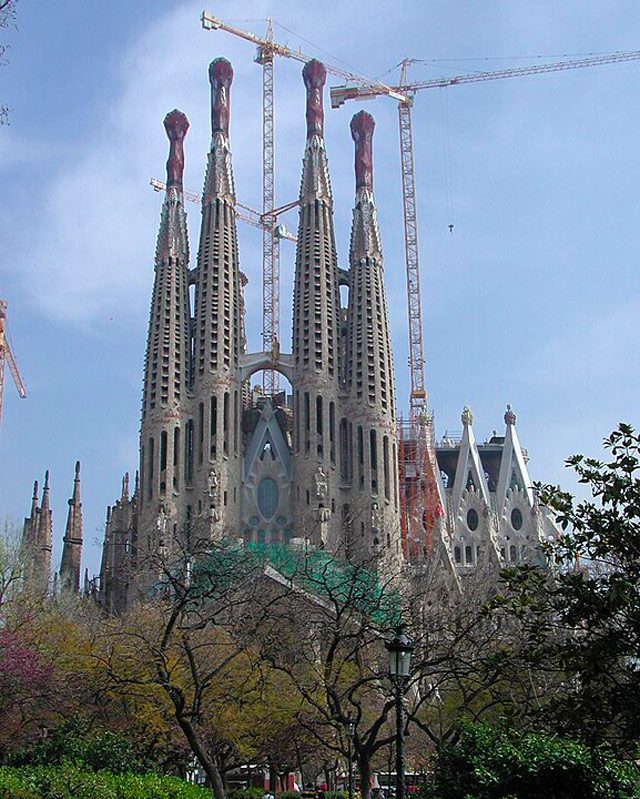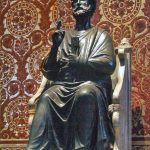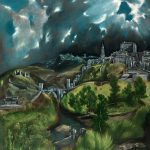
Barcelona is known for its beautiful beaches, rich history, and vibrant culture, but there’s one sight that stands above all others—literally. La Sagrada Familia, the towering basilica, dominates the city’s skyline and remains one of the most breathtaking architectural achievements in the world. It’s a building that has been under construction for more than 140 years, and it’s still not finished. That’s right—this architectural gem, designed by Antoni Gaudí, has been in the making since 1882, with an estimated completion date set for 2026.
Why has it taken so long to finish? What makes La Sagrada Familia such an iconic masterpiece? In this article, we’ll dive into the history, architecture, and ongoing construction of this one-of-a-kind basilica that has captured the world’s imagination.
Who Was Antoni Gaudí? The Visionary Behind La Sagrada Familia
To understand La Sagrada Familia, you need to understand Antoni Gaudí, the brilliant architect behind its design. Born in 1852 in Reus, Spain, Gaudí was a key figure in Catalan Modernism, a movement known for its intricate designs and bold use of color and form. Gaudí’s style blended Gothic architecture with Art Nouveau, creating something entirely his own. His works are scattered across Barcelona, from the whimsical Park Güell to the intricate Casa Batlló. However, La Sagrada Familia is considered his magnum opus.
Gaudí wasn’t just an architect; he was a deeply religious man, and his faith played a significant role in shaping La Sagrada Familia. He took over the project in 1883, after another architect had laid the foundation. From the start, Gaudí envisioned the basilica as a “Bible made of stone,” where every element would tell a story from the Christian faith. When asked about the lengthy construction process, Gaudí is reported to have said, “My client is not in a hurry,” referring to God.
His work on the basilica consumed the last years of his life. By the time he died in 1926, only one of the eighteen planned towers had been completed. Gaudí’s influence on the project, however, was so profound that modern architects have continued to follow his original blueprints—although not without some controversy.
A Church Unlike Any Other: Unique Architectural Features
La Sagrada Familia is unlike any other church in the world, both inside and out. Standing in front of it, you are greeted by three intricate façades, each representing a different aspect of the life of Jesus Christ. The Nativity Façade, completed during Gaudí’s lifetime, celebrates the birth of Christ. It is the most detailed of the three, filled with carvings of plants, animals, and biblical figures, each telling its own story. The Passion Façade, which represents the suffering and crucifixion of Jesus, contrasts the Nativity with its stark, angular design. Finally, the Glory Façade, which is still under construction, will symbolize Christ’s ascension to Heaven.
The basilica will eventually boast eighteen towers, with the central tower—dedicated to Jesus Christ—set to be the tallest at 172.5 meters (566 feet). This will make La Sagrada Familia the tallest religious building in Europe. Gaudí intentionally designed it to be just shorter than the nearby Montjuïc hill because he believed that human creations should never surpass God’s natural creations.
Inside, La Sagrada Familia is equally breathtaking. The columns supporting the basilica rise like tree trunks, branching out toward the ceiling. Gaudí designed the interior to resemble a forest, with light streaming in through vibrant stained-glass windows that bathe the entire space in color. Stepping inside feels like stepping into a kaleidoscope of blues, reds, and yellows. Every detail, from the carvings on the ceiling to the ironwork on the doors, is meticulously crafted to create an otherworldly atmosphere.
The acoustics are also carefully designed. Gaudí believed that sound and light should work together to create a spiritual experience. Whether you’re attending a mass or simply walking through, the way the space resonates with both light and sound is an unforgettable experience.
The Sacred Symbolism: A Spiritual Journey Through Stone
Gaudí’s vision for La Sagrada Familia was not just about architecture—it was about faith. Every inch of the basilica is imbued with religious symbolism, making it a place of worship as much as it is a work of art. From the façades to the towers, each element is meant to reflect a biblical story or theological concept.
The Nativity Façade is packed with detail, representing the joyous aspects of Christ’s birth and early life. Among its many sculptures, you’ll find depictions of the Holy Family, angels, and scenes from the Old Testament. Every figure is designed to convey a sense of hope and life, fitting for the story of the Nativity.
In contrast, the Passion Façade is much more austere, with harsh lines and dramatic shadows. This part of the basilica represents the suffering of Christ during his crucifixion. Gaudí designed it to be stripped of ornamentation to convey the starkness of death and sacrifice. The stone figures appear gaunt and emaciated, a visual representation of agony.
The basilica’s design also incorporates the natural world, which Gaudí saw as a reflection of God’s creation. The interior columns, for instance, resemble trees, and the stained glass mirrors the colors of the sky and sea. “Nothing is art if it does not come from nature,” Gaudí famously said, and this belief is woven throughout the basilica’s design.
Perhaps most intriguing is Gaudí’s use of geometry. He believed that mathematics, like nature, was a divine language. The towers of La Sagrada Familia are shaped in hyperboloids, a type of curve found in nature. Even the smallest details—like the angles of the stone carvings—are carefully calculated to reflect divine order.
140 Years in the Making: Why Is It Still Not Finished?
La Sagrada Familia’s construction began in 1882, and here we are, over 140 years later, and it’s still not finished. So, what’s taking so long? The answer is a mix of ambition, financial challenges, and historical events that have slowed the process.
When construction started, it was funded entirely by private donations, which limited the pace at which work could progress. Gaudí himself often worked with very little funding, relying on the generosity of patrons. Then came the Spanish Civil War in the 1930s, which halted construction altogether. Many of Gaudí’s original plans were destroyed during the war, further delaying progress.
After the war, work resumed, but it was slow going. La Sagrada Familia remained a construction site for decades, with only a few architects willing to take on the project. It wasn’t until the late 20th century, when tourism to Barcelona skyrocketed, that funding picked up again. Today, ticket sales from visitors provide the bulk of the funding for the ongoing work.
In recent years, advances in technology have sped up construction significantly. Architects now use 3D printing and other modern techniques to replicate Gaudí’s intricate designs, something that would have been impossible in his time. These innovations are why the current completion date is set for 2026, which will mark the 100th anniversary of Gaudí’s death. Whether or not this deadline will be met is still up for debate, but one thing is for sure—La Sagrada Familia’s long construction is part of its legend.
Gaudí’s Unfinished Legacy: The Debate Around Modern Additions
As La Sagrada Familia inches closer to completion, it raises a question: Can a building that’s been under construction for so long still stay true to its original design? Since Gaudí’s death in 1926, several architects have taken over the project, each bringing their own interpretations to his plans. Some argue that the newer additions lack the magic and originality of Gaudí’s work.
The Passion Façade, in particular, has sparked controversy. Designed by sculptor Josep Maria Subirachs, this part of the basilica uses sharp, angular lines and a minimalist style—very different from the naturalistic, flowing forms that Gaudí favored. While some praise it for capturing the brutality of Christ’s crucifixion, others feel it clashes with Gaudí’s vision.
The interior, too, has evolved over time. Modern architects have had to make decisions about how to interpret Gaudí’s unfinished blueprints, and not everyone agrees with the results. Some critics argue that the use of contemporary materials and techniques takes away from the authenticity of Gaudí’s original vision. However, supporters claim that the basilica, like any great work of art, should evolve over time.
Gaudí himself famously said, “The straight line belongs to man, the curved line belongs to God.” This statement encapsulates his philosophy, and it’s at the heart of the debate about how much freedom modern architects should have in completing La Sagrada Familia. While there’s no easy answer, the ongoing construction ensures that Gaudí’s masterpiece remains a living, breathing project—one that continues to evolve.
La Sagrada Familia and UNESCO: A World Heritage Site
In 1984, UNESCO recognized La Sagrada Familia as a World Heritage Site, further cementing its status as a global icon. It’s part of a larger collection of Gaudí’s works in Barcelona that have earned this prestigious designation, including Park Güell and Casa Milà. UNESCO praised the basilica for its unique architectural and artistic significance, noting that it represents a fusion of Gothic and Art Nouveau styles like no other building in the world.
This designation has not only boosted tourism but also provided additional protection for the basilica. As a UNESCO World Heritage Site, La Sagrada Familia is now safeguarded against any future developments that could compromise its integrity. This status ensures that future generations will be able to appreciate the basilica in all its glory.
However, the designation also comes with challenges. UNESCO has strict guidelines about how World Heritage Sites can be modified, which means that the ongoing construction of La Sagrada Familia has to meet specific criteria. Any changes to the design must respect Gaudí’s original vision while also meeting modern safety and engineering standards. It’s a delicate balance, but one that the team of architects working on the project has embraced.
Planning Your Visit: Tips for Travelers
If you’re planning a trip to Barcelona, visiting La Sagrada Familia should be at the top of your list. But with millions of tourists flocking to see the basilica every year, a bit of planning can go a long way in making your visit more enjoyable.
First, consider buying your tickets online in advance. La Sagrada Familia is one of the most visited landmarks in the world, and the lines to buy tickets on-site can be long. By booking ahead, you can skip the lines and go straight to exploring. There are also several guided tours available, which provide valuable insights into the history and architecture of the basilica.
The best time to visit is early in the morning or late in the afternoon, when the crowds are smaller and the sunlight streams through the stained glass at its most beautiful. If you want to get a bird’s-eye view of Barcelona, consider purchasing a ticket to climb one of the towers. The views from the top are stunning, but be prepared for a steep, winding staircase to get there.
Inside the basilica, don’t miss the crypt, where Gaudí is buried. It’s a quieter, more reflective part of the church, perfect for those looking for a moment of peace. And of course, take your time admiring the façades—each one tells its own story, and there’s always a new detail to discover.
La Sagrada Familia in Popular Culture
La Sagrada Familia isn’t just famous among architects and historians—it’s also made its mark on popular culture. The basilica has appeared in several films, TV shows, and books over the years. It played a central role in the 2011 Woody Allen film “Vicky Cristina Barcelona,” where the characters visit the basilica and marvel at its beauty. The building has also been featured in countless travel documentaries, music videos, and even video games.
Famous visitors have included everyone from Pope Benedict XVI, who consecrated the basilica as a minor basilica in 2010, to celebrities like Shakira and Lionel Messi. Social media has also played a significant role in spreading the basilica’s fame, with millions of people posting photos of the church’s stunning façades and interiors on Instagram every year.
The basilica’s fame continues to grow, making it one of the most recognizable buildings in the world. Whether you’re an architecture buff or just someone who appreciates beauty, La Sagrada Familia offers something for everyone.
The Future of La Sagrada Familia: Will It Ever Be Finished?
So, will La Sagrada Familia ever be finished? The current goal is to complete the basilica by 2026, which would mark the 100th anniversary of Gaudí’s death. However, delays caused by the COVID-19 pandemic have made that deadline uncertain. Even if the basilica is completed by 2026, it’s likely that smaller details will continue to be added for years to come.
One of the biggest questions is how the public will react once the basilica is finished. Will it lose some of its mystique, or will it continue to draw millions of visitors each year? Some argue that the unfinished state of La Sagrada Familia is part of its charm, a testament to Gaudí’s unrelenting vision and the dedication of those who have worked on it for over a century.
What is certain is that La Sagrada Familia will remain a symbol of faith, creativity, and perseverance for generations to come. As Gaudí himself said, “The creation continues incessantly through the media of man.” And as long as La Sagrada Familia stands, that creation will never truly be complete.
Key Takeaways
- La Sagrada Familia has been under construction for over 140 years and is still not finished.
- Antoni Gaudí designed the basilica, blending Gothic and Art Nouveau styles with deep religious symbolism.
- The basilica’s ongoing construction has sparked debates about whether modern additions stay true to Gaudí’s original vision.
- La Sagrada Familia is a UNESCO World Heritage Site, attracting millions of visitors each year.
- The estimated completion date is 2026, but the basilica may continue evolving even after that.
As Pope Benedict XVI said during his 2010 visit to the basilica, “Gaudí, through his work, wanted to lead people to God.” It’s a fitting summary of the spirit behind this incredible building, one that continues to inspire and amaze visitors from around the world.




